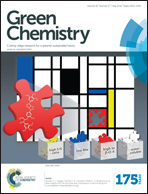Deep eutectic solvents as attractive media for CO2 capture†
Abstract
We report a family of deep eutectic solvents (DESs) consisting of various hydrogen bonding donor–acceptor pairs as CO2 capturing media. These DESs capture CO2via carbamate formation upon reaction between their hydrogen bonding donor units and CO2. Among the members tested herein, a DES made up of monoethanolamine hydrochloride–ethylenediamine exhibits an unprecedentedly high gravimetric uptake of 33.7 wt% with good initial kinetics (25.2 wt% uptake within 2.5 min) and recyclability. The given DES also shows sustainable performance in the presence of water, decent tolerance against temperature rise, and a relatively low heat of absorption which is attractive for regeneration. Even with the high gravimetric uptake, the DES has a far more suppressed corrosiveness compared to its pure monoethanolamine and ethylenediamine counterparts due to low oxygen/moisture permeability and the hydrogen bonding network that alleviates the corrosion redox cycle. The observed excellent properties in various key aspects of CO2 capture suggest that DESs are strong candidates to replace the conventional monoethanolamine-based scrubbing technology and are worth further exploration.


 Please wait while we load your content...
Please wait while we load your content...